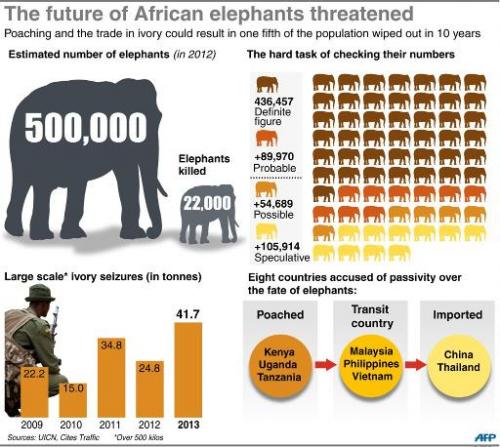Elephant Poaching in Africa - Some Statistics 2012/2013
Posted: Tue May 28, 2013 5:31 pm
2012 another deadly year for elephants in Africa: CITES
(AFP) – Feb 19, 2013
NAIROBI — The number of African elephants killed by poachers in 2012 will most likely be higher than the 25,000 illegally killed the previous year, the head of UN wildlife trade regulator CITES said Tuesday.
"Right across the range of the African elephant, in 2011 25,000 elephants were illegally killed, and based upon our analysis done so far, 2012 looks like the situation deteriorated rather than improved," said CITES Secretary General John Scanlon.
The 25,000 killed in 2011 includes 17,000 dead elephants actually recorded by CITES in some 40 percent of the animals' range, with the remainder an extrapolation.
Iain Douglas-Hamilton, the founder of Save the Elephants, said that while in terms of sheer numbers killed the 1970s and 1980s was worse, the situation today was a "very big crisis" and in "other ways it is much worse."
Today "there are fewer elephants and demand for ivory seems to be even higher", Douglas-Hamilton told reporters, on the sidelines of a meeting at the United Nations Environment Programme (UNEP) headquarters in Nairobi.
David Higgins, chief of Interpol's environmental crime division, said that poaching involved organised crime gangs, in addition to noting links to insurgent groups in Africa and possible links to terrorist organisations.
"Unless we break these criminal networks, it will continue," Higgins said.
Africa has seen a sharp rise in the illegal trade in wildlife products like ivory and rhino horn.
Poaching has spiked recently in Africa, with whole herds of elephants massacred for their ivory.
One kilogramme (about two pounds) of ivory is currently estimated to be worth around $2,000 on the Asian black market.
Rhino horn can sell for as much as $80,000 a kilo, and poachers have killed some 2,000 rhinos in the past two years, a huge number considering only about 25,000 rhinos remain.
The illegal ivory trade is mostly fuelled by demand in Asia and the Middle East, where elephant tusks and rhinoceros horns are used to make ornaments and in traditional medicine.
Trade in elephant ivory, with rare exceptions, has been outlawed since 1989 after elephant populations in Africa dwindled from millions in the mid-20th century to some 600,000 by the end of the 1980s.
Africa is now home to an estimated 472,000 elephants, whose survival is threatened by poaching as well as a rising human population that is causing habitat loss.
(AFP) – Feb 19, 2013
NAIROBI — The number of African elephants killed by poachers in 2012 will most likely be higher than the 25,000 illegally killed the previous year, the head of UN wildlife trade regulator CITES said Tuesday.
"Right across the range of the African elephant, in 2011 25,000 elephants were illegally killed, and based upon our analysis done so far, 2012 looks like the situation deteriorated rather than improved," said CITES Secretary General John Scanlon.
The 25,000 killed in 2011 includes 17,000 dead elephants actually recorded by CITES in some 40 percent of the animals' range, with the remainder an extrapolation.
Iain Douglas-Hamilton, the founder of Save the Elephants, said that while in terms of sheer numbers killed the 1970s and 1980s was worse, the situation today was a "very big crisis" and in "other ways it is much worse."
Today "there are fewer elephants and demand for ivory seems to be even higher", Douglas-Hamilton told reporters, on the sidelines of a meeting at the United Nations Environment Programme (UNEP) headquarters in Nairobi.
David Higgins, chief of Interpol's environmental crime division, said that poaching involved organised crime gangs, in addition to noting links to insurgent groups in Africa and possible links to terrorist organisations.
"Unless we break these criminal networks, it will continue," Higgins said.
Africa has seen a sharp rise in the illegal trade in wildlife products like ivory and rhino horn.
Poaching has spiked recently in Africa, with whole herds of elephants massacred for their ivory.
One kilogramme (about two pounds) of ivory is currently estimated to be worth around $2,000 on the Asian black market.
Rhino horn can sell for as much as $80,000 a kilo, and poachers have killed some 2,000 rhinos in the past two years, a huge number considering only about 25,000 rhinos remain.
The illegal ivory trade is mostly fuelled by demand in Asia and the Middle East, where elephant tusks and rhinoceros horns are used to make ornaments and in traditional medicine.
Trade in elephant ivory, with rare exceptions, has been outlawed since 1989 after elephant populations in Africa dwindled from millions in the mid-20th century to some 600,000 by the end of the 1980s.
Africa is now home to an estimated 472,000 elephants, whose survival is threatened by poaching as well as a rising human population that is causing habitat loss.
